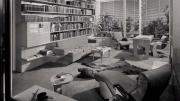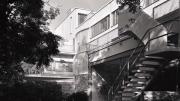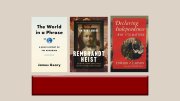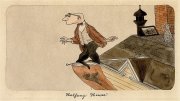Bach’s Musical Universe: The Composer and His Work, by Christoph Wolff, Adams University Professor emeritus (W.W. Norton, $40). The preeminent Bach scholar (and biographer) here places the composer’s music in context by diving deep into selected works, organized not by period or genre, but by their “transformative musical ideas” for Bach himself.
Fighting Words, by Nancy F. Cott, Trumbull research professor of American history (Basic Books, $32). In a volume subtitled “The bold American journalists who brought the world home between the wars,” Cott follows the correspondents who worked the globe from Palestine to revolutionary China, as well as Europe, during the ascent of Hitler and Stalin: Dorothy Thompson, James Vincent Sheean, John Gunther, and Rayna Raphaelson. Given many Americans’ current inwardly directed state, a successor generation who might explore and interpret the rest of humanity would be refreshing, welcome, and important.
1774: The Long Year of Revolution, by Mary Beth Norton, Ph.D. ’69 (Knopf, $32.50). Cornell’s Alger professor of American history emerita looks at the 16 months between the Boston Tea Party and the battles of Lexington and Concord, during which war between colony and parent became inevitable. A brisk, informed narrative, it amply rewards revisiting what may initially have seemed familiar events.
Serious Noticing: Selected Essays, 1997-2019, by James Wood, professor of the practice of literary criticism (Farrar, Straus and Giroux, $35). The critic (The New Yorker, the London Review, etc.), collects writing about writers canonical and contemporary. He aims, he observes, to “do three things at once” in his work: speak about fiction “as writers speak about their craft”; write “criticism journalistically, with verve and appeal”; and bend such criticism “back towards the academy in the hope of influencing the kind of writing that is done there.”
Spenserian Moments, by Gordon Teskey, professor of English (Harvard, $45). Barely four years after his expansive The Poetry of John Milton, the author is back with a vast essay collection centered on Edmund Spenser’s Faerie Queene—which he says is, “unlike Paradise Lost, capable of indefinite extension, like the opening spiral of a nautilus shell,” and therefore examines not as a poetic object but rather as “an ongoing creative project into which the unpredictable enters with time.”
The Rule of Five: Making Climate History at the Supreme Court, by Richard J. Lazarus, Aibel professor of law (Harvard, $29.95). The author, expert in both environmental law and Supreme Court advocacy, combines those perspectives to craft an exciting, accessible narrative about Massachusetts vs. United States Environmental Protection Agency, the 2007 opinion that, after much litigating, authorized federal regulation of carbon dioxide and other greenhouse-gas emissions. Beyond that focus, many readers may find the book especially valuable for its explanation of the practicalities of winning a court ruling: getting to those five votes in favor of one side or the other.
Alan I.W. Frank House (Rizzoli, $65). In this Bauhaus centennial year (see “What a Human Should Be,” March-April 2019, page 44), the stupendous Pittsburgh home designed by Walter Gropius, newly arrived to lead the Graduate School of Design, and Marcel Breuer, and built by the family behind Copperweld—intact, restored, and still inhabited by their son, Alan I. W. Frank ’54—is documented and celebrated in a lush, large-format book appropriate to the scale and importance of the residence as an icon of modernist design. With essays by architectural historians Kenneth Frampton, Loeb Fellow ’73, Barry Bergdoll, and Charles A. Birnbaum, Loeb Fellow ’98.
What Remains: Bringing America’s Missing Home from the Vietnam War, by Sarah E. Wagner, Ph.D. ’06 (Harvard, $29.95). The haunting double meaning of the title underscores the difficult subject: the search for the unaccounted-for war dead, the new technologies used to identify remains, the people who do this work (always in demand, given the nation’s long wars, and the devastation wrought by terrorist attacks like 9/11), and the multiple meanings of the results. The author, an anthropologist at George Washington University, writes with an ethnographer’s sensitivity and eye for detail.
Visualizing Taste, by Ai Hisano (Harvard, $39.95). A former postdoctoral fellow in business history at the Business School, now at Kyoto University, explains how the “natural” appearance of foods (why margarine is yellow) was socially, and most often commercially, constructed. Original and with vivid color plates: check out the advertisement for Du Pont Cellophane protecting red meat in the grocery stores of an earlier era.
Civil War Monuments and the Militarization of America, by Thomas J. Brown ’81, J.D. ’84, Ph.D. ’95 (University of North Carolina, $29.95 paper). How did a nation wary of a standing army come to erect war memorials seemingly everywhere? The author, a University of South Carolina historian, locates the phenomenon in the aftermath of the Civil War—and thus exposes a less observed and contested aspect of these memorials than the current reinterpretation of their connections to the legacy of slavery and the Confederacy. Harvard’s Memorial Hall appears numerous times.
Citizen Outlaw, by Charles Barber ’85 (Ecco, $27.99). A written-with-access account of William Outlaw’s trajectory from leading a cocaine gang in New Haven, through extended imprisonment for homicide and armed assault, to release and a new, constructive role as community advocate on those same streets. The author knows the terrain well: he is a lecturer in psychiatry at Yale, and writer-in-residence at Wesleyan.
The Caste of Merit: Engineering Education in India, by Ajantha Subramanian, professor of anthropology (Harvard, $49.95). An academic, demanding study of the persistence of caste and severe social stratification in India, as exemplified by access to its elite engineering universities. Useful for understanding contemporary India and—in its explication of how “the notion of meritocracy, like that of a color-blind society, has come to serve the reproduction of inequality”—the contemporary United States.
India’s Founding Moment: The Constitution of a Most Surprising Democracy, by Madhav Khosla, Junior Fellow (Harvard, $45). A legal scholar and political theorist examines the constitution—effective in 1950, after the end of British colonial rule—of the world’s largest democracy. The “universalism” it embodied seems threatened today, to say the least. “Modern political life,” he notes in conclusion, “will of course remain an area of rational and irrational contests, a sphere that is home to frustrated hopes, dangerous fantasies, and surprising victories.” For India’s democracy today, one may well wish that the last of these descriptions holds true.
Why Liberalism Works, by Deirdre Nansen McCloskey ’64, Ph.D. ’70 (Yale, $28). An economist revisits the traditional, eighteenth-century—Locke, Smith, Voltaire, et alii—meaning of the word to remind today’s tribal politicians and citizens that the best way to overcome poverty and tyranny is through the “true liberal values” invoked in the subtitle: freedom, equality, and prosperity.
Magdalena: River of Dreams, by Wade Davis ’75, Ph.D. ’86 (Knopf, $30). The anthropologist/ethnobotanist/explorer delivers a loving paean to Colombia, where he came of age, and its mighty river, the Magdalena. He is alive to the country’s “mountains and forests, rivers and wetlands…and the beauty and power of every tropical glen and snow-crested equitorial peak”—and to the character of the people they have shaped, who “long for peace” from the world’s, and their own, cocaine-fueled conflicts.
The Dolphin: Two Versions, 1972-1973, by Robert Lowell, and The Dolphin Letters, 1970-1979, both edited by Saskia Hamilton, (Farrar, Straus, and Giroux; $16 paper and $50, respectively). The 1974 Pulitzer Prize poem by Lowell ’39, and the indispensable, shattering correspondence of the life events underlying them involving Elizabeth Hardwick, Lowell (see “The Brahmin Rebel,” May-June 2004, page 39), and their circle. Invaluable for understanding many of the principals, and sometimes horrifying given their wounding behavior (Lowell’s particularly) toward their suffering loved ones.
My City of Dreams, by Lisa Gruenberg, assistant professor of medicine (TidePool Press, $28.) In this carefully researched and hauntingly written memoir, the author—the daughter of a Holocaust survivor—not only records her own life, but also that of relatives long lost to darkness, terror, and murder.
Recognizing Wrongs, by John C.P. Goldberg, Carter professor of general jurisprudence, and Benjamin C. Zipursky (Harvard, $45). A legal theorists’ revisionist interpretation of tort law, written with admirable clarity. Given that “those who spend their time studying tort law…often are least in tune with its commensensical roots,” they clear the air thus: “One who wrongfully injures another can be held accountable by the victim.” From there, naturally, many complications, philosophical and otherwise, ensue.












